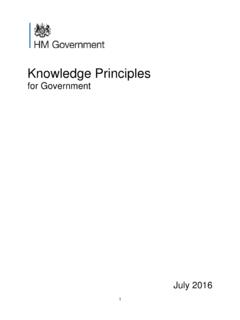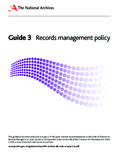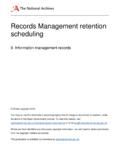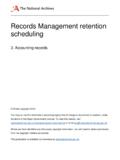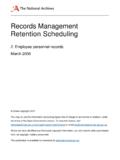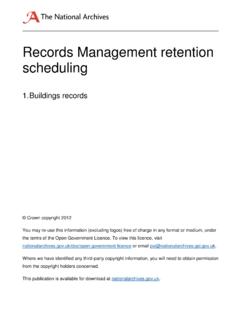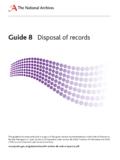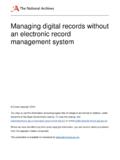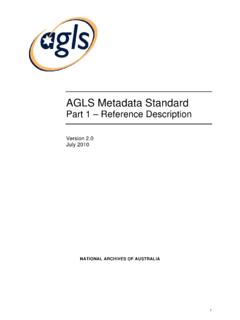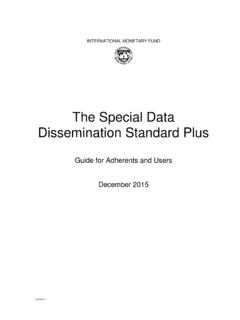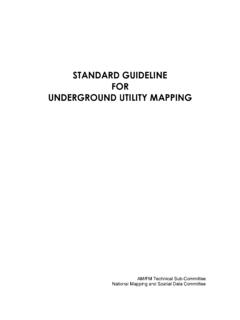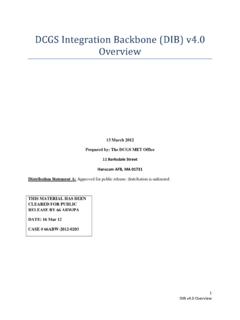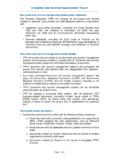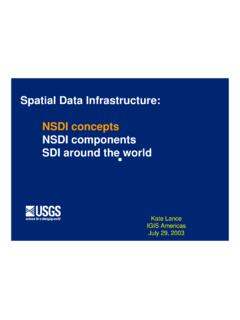Transcription of This document is no longer current. Please go to …
1 This document is no longer current . Please go to the following URL for more information: Requirements for Electronic Records Management Systems 4: Implementation guidance September 2004 Page of 25 2 Table of Contents 1 Implementing Electronic Records 2 Degree of Responding to requests for change (RFCs)..5 3 Functionality supporting Freedom of Information implementation and other openness 4 Placement of optional modules on case and workflow management and content R le of 5 Major configuration Entity behaviour Rules observed by classification scheme and its Folders within folders, records higher up the classification Use of folder parts in disposal Defaults, settings for documents and 6 R les and responsibilities (functional access rights)..13 General configuration Access control configuration Access to records from outside the 7 Usability and The end user and records management metadata The average end-user and metadata Other information management Metadata implications of the degree of integration between the document and records management Resource discovery (searching) in a records management Display of metadata attributes vs.
2 / holding at system [database] Formation of names etc, in Metadata Sources of the 8 Positioning of Metadata Producing a local metadata schema: relationship with e-GMS elements not Metadata elements slightly different in scope in Different obligation 9 Archival HD and D 10 XML schema representation of records management Metadata Page of 25 Summary Page of 25 4 1 Implementing Electronic Records Management Introduction Guidance on successful implementation of electronic records management can exist on a number of different levels: introducing, integrating and configuring a software package (or ERMS ); perhaps including in the above some closely associated application-level software capabilities such as workflow, document management, case management; user culture change and training; wider infrastructure change issues, such as enterprise content management, line of business applications or e-Government platforms; intellectual control issues implemented within the ERM environment, such as the business classification scheme; business benefits realisation; and more comprehensive programmes of business change including business process re-engineering.
3 This guidance only deals with the first and touches on the second of these scenarios as it applies to the type of environment set out in volumes 1 3 of this series (separate guidance will address the third on the premise that electronic records management is an activity; something an organisation does, rather than simply the implementation of a software package). There is also some high level rationale provided on why parts of the Functional requirements are couched in the way they are. Other TNA guidance already exists on the following subjects1 and has been written with the electronic environment particularly in mind: guidance for the development of an email policy; business classification scheme design; disposal scheduling; ePolicy framework for electronic records management (published in collaboration with the e-Government Unit of the Cabinet Office).
4 Within this scope, it is not the intention to provide a Configuration toolkit . Off-the-shelf and bespoke software solutions will be too diverse to make that possible. Instead, explanation of higher level issues on the possibilities of the configuration are given to assist public authorities in clarifying their needs in this respect. References to specific functional requirements (from volume 1) and other parts of this series of publications are given where appropriate. 1 All accessible through: Page of 25 52 Degree of configurability General There is one overriding point that needs to be borne in mind when considering configuration issues for this type of solution. It is likely that proprietary software capable of compliance with the functional requirements will be also capable of a high degree of configuration, so that the software could be configured out of as well as into compliance with the requirements.
5 This is particularly marked where the overriding concern in the product design was document , rather than records management. Care and attention to detail are required to ensure that this does not occur, especially in the sourcing, capture and subsequent handling of metadata. For some further detail in this area, refer to section 7 of this guidance. Responding to requests for change (RFCs) This and other TNA guidance stresses the need to maximise the usability of the system for the end user. It is only in this way that user buy-in can be maintained and this is essential to the capture of the corporate record. Due to the desire to ensure user buy-in, system administrators may occasionally be asked to make configuration changes that will compromise the robust handling of the records to a degree that makes the system incompatible with the generic requirements.
6 These requests must be declined and an explanation given. Page of 25 6 3 Functionality supporting Freedom of Information implementation and other openness legislation General Robust records management has a vital part to play in supporting the implementation of both the Data Protection Act 1998 ( DPA ) and the Freedom of Information Act 2000 ( FOIA ). The general management principles will aid DPA compliance, as may incidental functionality2 such as contacts or locations features that may exist within a proprietary product and / or its integration with an email client. The role with respect to FOIA operates at a number of levels: Knowing what is held and how it is managed is vital to the servicing of access requests. The Lord Chancellor s Code of Practice under section 46 of the FOIA requires public sector organisations to have an appropriate records management capability in terms of resources, organisational placement and sets out the main components of a records management programme.
7 Aside from the importance of this, there are more specific points about improving the information management and retrieval capabilities of public authorities that the electronic records environment is uniquely equipped to support. This section concentrates on explaining how specific functionality in the Functional requirements can aid compliance with openness and privacy legislation and the rationale behind it. Electronic records management on the model of the Functional requirements introduces degrees of auditability of records management activity that could only be dreamed of in the paper environment. Simultaneous with the implementation of the FOIA 2000 and the push to online, web-based government, it also follows that a far greater proportion of data relating to private individuals will be processed electronically and this must be done in accordance with the Data Protection Act 1998.
8 The need is to strike the correct balance between openness and accountability with the privacy of personal information processed in the course of public business. The retrospective nature of FOIA means that it will apply to large quantities of legacy information in both paper and electronic formats. As the Lord Chancellor s Code of Practice encourages good practice in records management, the Information Tribunal and the Information Commissioner may not accept that poor records management in the past is an adequate defence against demands for openness and accountability from citizens. Further guidance on the more general records management implications of openness legislation are contained in the following publications: DPA: a guide for records managers and archivists, TNA 2000 2 In the sense of not being specified in the Requirements Page of 25 7 Manual of guidance on access to public records, TNA 2001 (revision in progress, 2004) Draft Code of Practice under DPA s.
9 51, Society of Archivists, 2002 Support for FOIA 2000, DPA 1998, etc. in the Requirements The Functional Requirements contained for the first time a number of features aimed at supporting recent access legislation: The concept of the non-default Record_type (aimed solely at facilitating DPA compliance) where, exceptionally, a restricted type of document can inherit its disposal schedule from its type rather than the folder it is contained within; The Presentation requirements (non-mandatory requirements ) for making record metadata and / or content available by a process of web publication, to assist in the administration of an FOI publication scheme; Rendition and other multiple manifestation requirements such as the holding of redacted versions of records (called extracts in the Functional Requirements), to provide access copies within an ERMS or archival system, perhaps to safeguard personal data or sensitive information whilst making the rest available; Disposal hold where a record or group of records due for disposal can be retained temporarily, such as for litigation or responding to an FOI request (Requirements - ); Disposal roles (Requirement ) separating out the ability to run the disposal of the objects and metadata from the databases from the ability to apply a disposal schedule execution to provide assurance that a FOIA offence has not been committed.
10 Access control requirements for the automatic declassification (Requirement A ) and progressive downgrading of folders and records. Note: Not all these requirements fall within the mandatory set: public authorities should consider whether they need them or whether they have alternative solutions to some of the same issues. Interface with applications to track compliance with openness legislation, especially FOIA Interoperability may be required with FOIA tracking systems in several scenarios: where a request is held for information contained in records in an electronic records management system; where the ERMS is the tool for capturing the records of the FOIA request case or workflow; Page of 25 8 where it is useful to access information on previous FOIA release decisions prior to exporting records to archival custody3 [potentially] for cross-government monitoring purposes; [potentially] where a cross government tracking system is involved.
